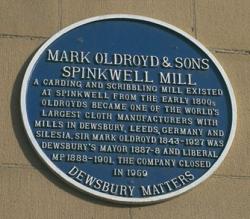Making Shoddy abroad
The demand for rags was such that large amounts were imported, and we hear of at least two Batley men, John Jubb and Benjamin Senior visiting the ports themselves to buy rags in the early years of the trade. It seems to have been because of export duties imposed that local men began to think of making the Shoddy itself abroad.
Writing in 1860 Samuel Jubb said the weight of imported shoddy and mungo was then estimated roughly to amount to 10,000 tons yearly, most of which , probably three-quarters of it imported via Hull, found its way into the Batley district. He says
"These imports are supplied by the Continent of Europe, and almost all, or at least the great bulk, by Germany and Denmark: in the latter country, manufactories for the production of rag wool have existed for a length of time, a period of full thirty years, and the Danes have ling been noted for their excellent qualities thereof. the manufacture of this commodity on the continent has, like our own, increased gradually and largely, and has there spread itsellf over a wide space of territory - a space embracing several Governmants, by whom it is fostered.and encouraged. At Berlin there is a number of manufactories of rag wool, several of which have been established by enterprising Dewsbury and Batley people: these factories produce both shoddy and mungo, and appear to be successful undertakings. The principal reason why our countrymen prosecute this business in Berlin and other places in Prussia is, because that government places a heavy duty on the exportation of rags, and permits shoddy to go out free, thus affording facilities for an export trade in rag-wool not extended to rags."
F. W. Reuss, himself a merchant, made an interesting comment in an article on the origins of Shoddy and Mungo that traditionally a Mr Beck, residing in Denmark, was the first producer and exporter of Shoddy on the Continent in the mid eighteen-thirties. We might speculate as to the destination of rag machines exported from Hull in the later eighteen-thirties. However, most such ventures had their roots in the West Riding, and among the first were the ventures which John Blackburn was to own, begun by Joseph Pyrah and others in Berlin, and Benjamin Blakeley from Dewsbury in nearby Kopenick.
Another German venture was instigated by merchants. James Dodgshun, of a Morley family with interests in Leeds and abroad, and himself apparently for some time settled in Hamburg, applied to build a shoddy factory at Wittenberge on the Elbe in 1853. He was assisted by his son-in-law Joseph Naylor, whose father Abraham was also described as merchant, though of a Batley Carr manufacturing family. Joseph later took over this business, and the family settled there, though we find one of Joseph's sons Charles staying with an uncle in England in 1881, apparently to learn the dyeing trade there. Others from Batley are known to have worked in Wittenberge; John Thomas Parr, believed to have been employed to set up/manage a department there and Caleb Cowling and his son Joseph, described as master cloth-workers in an 1890 directory of Wittenberge. Edwin Hudswell from Batley is also said to have managed a branch of the business for many years, while Joseph Parker was described as agent for Messrs Dodgshun of Leeds and Morley.

Huge amounts of rags were still required, and James Colbeck, who entered the service of the Dewsbury firm of Mark Oldroyds in 1857, was sent first to Scotland and then to France in search of them, settling for a time in Douai. When the French also imposed duties on rag export it is said to have been at Messrs Oldroyds' instructions that Israel Colbeck, James's father's cousin, and previously a machine-maker in Batley, also went to France and fitted up some rag grinding machines there.
How far Oldroyds continued their involvement there is unclear, but Israel's son Edwin Colbeck married the widow of Josiah Greaves from Dewsbury, who had been working as a merchant in France. It seems that it was with Jane's inheritance that they set up a shoddy factory at Loups à Maromme near Rouen.
Writing in 1876, William Smith spoke of mungo rather than shoddy being produced in Morley, where he says there were then 30 rag machines producing 7,200,000 lbs per annum, but also says that an equal amount in weight is imported from elsewhere in England but also the Continent and especially Germany each year. He says that "the qualities of the mungoes sent to England from the last-named country are much superior to those of hime production, and are evidently the result of careful supervision in the sorting and subsequent processes"
Much later, we may note that it was a Canadian introduction of tariffs that led a twentieth century George Sheard to establish a shoddy based woollen mill there and subsequently found a venture of his own.